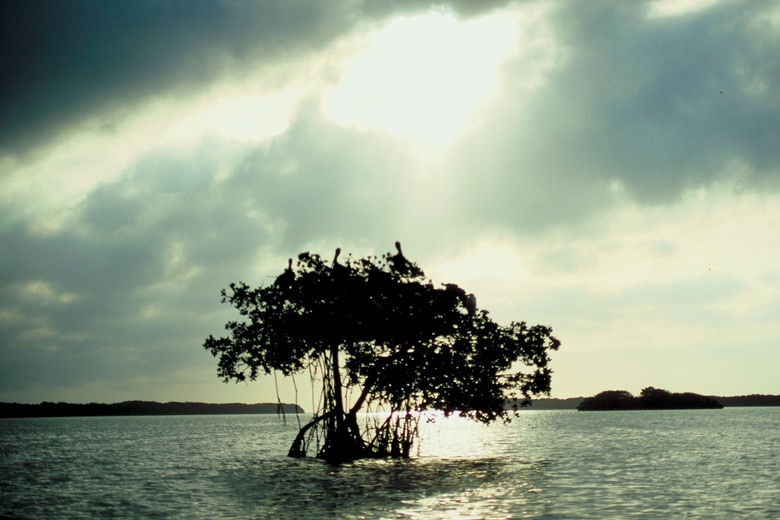Trees That Grow In Saltwater
You won't find very many trees in the ocean – or even near the ocean for that matter. Areas in close proximity to salt water, such as beaches, have high salinity in their soil, and the vast majority of tree species cannot survive in those types of conditions. Water droplets with salt in them, also known as salt spray, get blown into nearby areas and damage leaves as well.
Some plants, such as various species of oak, maple, magnolia, cedar and willow, can survive in conditions with high soil salinity or salt spray. However, mangroves are the only trees that grow directly in salt water.
Mangroves: Trees That Grow in Water
Mangroves: Trees That Grow in Water
You can find approximately 80 different species of mangrove trees in coastal regions around the globe. These aquatic trees live in warm tropical and subtropical regions. Incredibly unique among plants, these trees thrive in environments with their roots fully submerged in salt water for periods of time.
Surviving incredibly salty conditions and twice-daily flooding by the tides, not to mention adverse weather such as hurricanes, makes these trees one of the hardiest species on the planet.
Survival for Aquatic Trees
Survival for Aquatic Trees
For the majority of "normal" trees, high-saline soil means a death sentence. Tree roots typically absorb water while blocking salt. However, in soils with high salinity, the trees cannot properly absorb water from the soil. When the salinity is high enough, the salt can actually pull the water out of the plant's roots and dehydrate them through osmosis. In osmosis, water moves from areas of lower salinity to higher salinity.
Mangrove species counteract these effects in one of two fashions. Some species evolved a specialized barrier that blocks osmosis from occurring. Other species simply let the salt into their roots and then excrete it using special pores on their leaves.
Another potentially deadly impact for trees that grow in water is a lack of oxygen. Mangroves are subjected to flooding twice per day from the tides. Thankfully, they also have a unique adaptation to account for that loss of oxygen. They grow special roots, known as pneumatophores, which remain above the soil to absorb oxygen through the air.
Seed Distribution: The Perks of Oceanside Living
Seed Distribution: The Perks of Oceanside Living
Things aren't all bad for trees in the ocean! One major benefit to living within reach of the tide is the ability to disperse your seeds far and wide. Oceanic currents reach impressive distances, and mangrove trees use those currents to carry their progeny to new regions. However, they don't use seeds to do so.
Mangrove seeds pollinate and grow while still attached to the parent tree. The pollinated seedling, known as a propagule, then drops off the parent tree and drifts away to root and grow somewhere new.
Mangroves aren't the only species of tree that take advantage of ocean currents for distribution. The coconut palm famously spreads its seeds using the ocean for dispersal. The seeds of this palm, known as coconuts, float in water and begin to sprout when they reach land.
Mangrove Forests: Creating Ecosystems
Mangrove Forests: Creating Ecosystems
Mangrove trees' ability to survive where other trees cannot provides an incredibly unique ecosystem to the surrounding creatures. These trees use each other for stabilization in areas with muddy or loose soil. Essentially, they grow upon one another, and over time soil and sediment collect on their roots creating and expanding new land.
Mangrove forests also provide homes for a variety of animals. A variety of seabirds make their homes in the trees and build their nests in the branches while fishing in the surrounding waters to feed their young. Numerous crabs, shrimp, fish, oysters and more shelter beneath the stilted roots. Through their unique ability to survive in these harsh regions, mangroves sustain entire habitats and ecosystems.
Cite This Article
MLA
Zinni, Yasmin. "Trees That Grow In Saltwater" sciencing.com, https://www.sciencing.com/trees-that-grow-in-saltwater-13429031/. 30 September 2021.
APA
Zinni, Yasmin. (2021, September 30). Trees That Grow In Saltwater. sciencing.com. Retrieved from https://www.sciencing.com/trees-that-grow-in-saltwater-13429031/
Chicago
Zinni, Yasmin. Trees That Grow In Saltwater last modified March 24, 2022. https://www.sciencing.com/trees-that-grow-in-saltwater-13429031/
